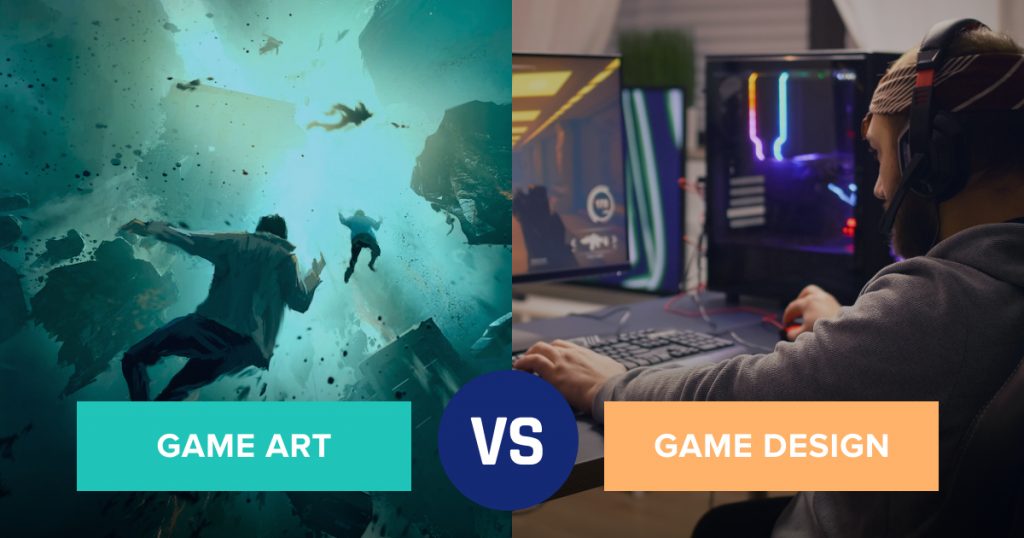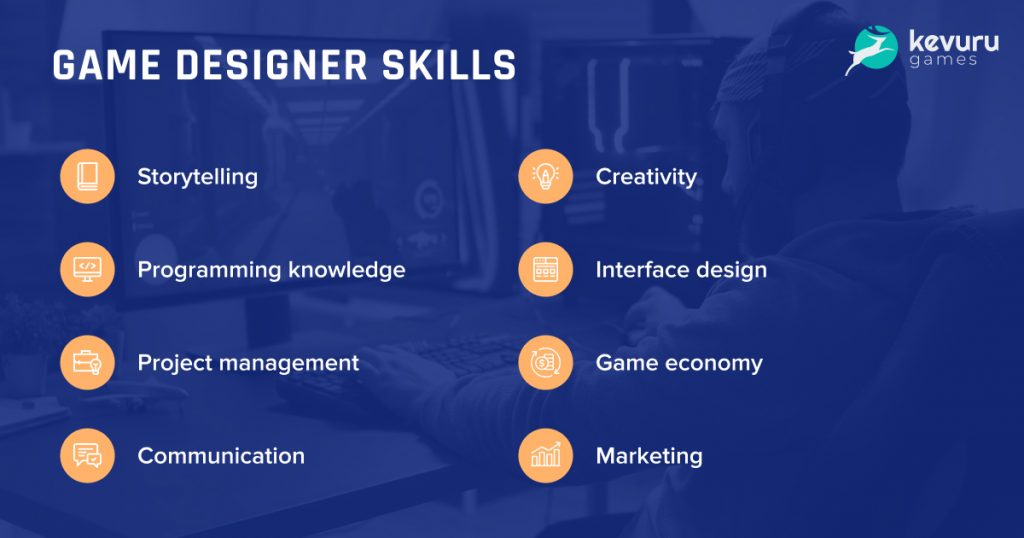Speaking about the creative component of creating a game, one cannot help but come across a game art vs game design discussion. Despite massive attempts to simplify everything, these are two completely different areas of work. We want to help you understand the difference between game design and game art and clearly define the responsibilities of each specialist.

Who is a Game Artist?
A game artist is a specialist who creates all the visual components of a game, from the sketch to the final render.
To understand the style that will become the foundation of their work, game artists draw information from the game design document, which is compiled by the game designer before starting work on the game. This is how art experts understand the right atmosphere and see the references, following which they will have to create art.
The task of the artist is to revive the game world, described in words, and tell the game story in visual language. Usually, their 2D art pipeline includes such steps as:
- Concepting.
- Black and white sketching.
- Color sketching.
- Rendering.
If this is the creation of 3D art, then the pipeline looks like this:
- Approving brief.
- Creating a high poly model.
- Creating a low poly model.
- UV and baking.
- Texturing.
Artist-created game assets compose and package the game world. Regardless of their number, all of them should correspond to the general style of the game and be consistent with the current game level.
Thus, game design vs game art are inextricably linked, and the game artist and game designer work together to correctly convey the visual style of the game.
The Role and Responsibilities of Game Artists
Creating game assets covers a large number of game areas. Therefore, artists are divided into several categories:
- Concept artist. Creating sketches and concept art in accordance with GDD.
- Character artist. Creating all game characters: people, animals, robots, etc.
- Environment artist. Creating game environment elements: nature, buildings, etc.
- UI/UX artist. Creating game interface elements: heads-up display (HUD) and menus.
This categorization allows each specialist to focus on their area and provide the best results.
HUD and menus are largely responsible for the game feel — the feeling of interacting with the interface. This includes the visual and audio effects of picking items and general art direction. But the requirements for different interface elements are different — HUD should be, first of all, easy to read, and menus should be easy to navigate.
Game Artist Skills Required

To do their job well, game artists must have the following skills:
- Drawing and composition basics. It is vital for an artist to have basic artistic knowledge and understanding of how to form a composition suitable for different genres.
- Software knowledge. To create 2D and 3D art, artists need to understand special software: Adobe Photoshop, Maya, 3ds Max, ZBrush, etc.
- High level of creativity. The artist must be able to easily and quickly generate different ideas based on the available information about the game style.
- Industry understanding. Knowing the nuances of the gameplay and having a baggage of knowledge about different games, the artist will have more opportunities for creativity.
- Openness to communication. The artist works in a team with a large number of other specialists, exchanging information, so it is important to be open to dialogue.
Who is a Game Designer?
A game designer is a specialist who comes up with the structure and rules of the game.
Thinking through the mechanics of the game, its goals, dynamics, development, and so on completely rests on the shoulders of the game designer. This specialist creates a so-called game design document, which includes all information about the game, from genre and audience to monetization and promotion methods.
The Role and Responsibilities of Game Designers
Speaking about the difference between game art and game design, we can safely say that art is about visuals, and design is about logic. It is the designer who explains to the artist how the game world should look and what objects should fill it. Unlike the artist, whose role is primarily creative, the role of a designer requires both creative and technical skills:
- Creative. The game designer comes up with ways to present the game plot, works out the script, and schematizes the game levels. Designers need to make sure that the artists understand the style and atmosphere of the game correctly and create appropriate visual content.
- Technical. On this side, the game designer must understand the technical limitations of the assigned platforms and the capabilities of the game engine. All other aspects of the game are thought out with this data in mind. The designer also thinks ahead about the involvement of the players and how they will interact with the game.
As the complexity of games increases, the work of a game designer becomes more and more extensive, which leads to a certain division of responsibilities. For example, you can meet a separate specialist called a level designer responsible for creating and implementing levels, stories and quests. Another kind of specialist, system designers, focus on gameplay, controls, combat, and more.
In summary, the job of a game designer includes but is not limited to such tasks.
- Developing game mechanics.
- Thinking through gameplay ideas.
- Defining genre and style.
- Writing stories and storylines.
- Developing and designing characters.
- Creating maps, scenarios, and difficulty levels.
- Thinking up ways to win and lose the game.
- Developing the user interface concept.
- Preparing game prototypes.
So that the result of working on all these tasks is not lost, the game designer puts them into a game design document. We talked in detail about its basic structure and provided a template in our material on game designers backstage — be sure to check it out to learn all the ins and outs of being a game designer.
Experience the specifics of the work of a game designer and get your comprehensive GDD template
Learn moreGame Designer Skills Required

Given the incredible amount of work that a game designer does, the requirements for this role also come down to a huge amount of skills:
- Storytelling. The game designer is often directly involved in creating the game’s storylines, character arcs, quests, and other narrative elements. Therefore, they need to understand the fundamentals of storytelling.
- Programming knowledge. A game designer must know the basics of programming and game engines to understand the technical limitations of different platforms and create correct and appropriate concepts.
- Project management. Game designers need to be able to allocate their time and the time of other specialists responsible for working on other aspects of the game to meet production deadlines.
- Communication. Game designers need to communicate more than anyone else. They must convey information to both artists and developers, and talk to testers and project managers so that all team members have a comprehensive understanding of the game.
- Creativity. A game designer without creativity will not be able to come up with an interesting and original game concept. These specialists should be able to create unique worlds, character development schemes, compelling storylines, and so on.
- Interface design. Despite the presence of a separate UI/UX specialist, it is important for a game designer to create a base for the entire interface design, think over the controls, menu content, and the presence of the necessary elements on the screen.
- Game economy. The game designer is responsible for designing the game’s economy, as well as character improvement schemes, which often involve a lot of numerical calculations. Therefore, it is important to have basic economic and financial knowledge.
- Marketing. Game designers also need to be well-versed in how the final product is promoted. This includes an understanding of the most appropriate strategies, platforms, approaches, and other things that will be optimal for a given game genre.
Game Art Vs Game Design
So what is the difference between game design and game art? Let’s highlight again:
- The game artist deals with the visual components of the game.
- The game designer thinks through the game mechanics, logic, and rules.
It is important for a game artist to be able to create art.
It is important for a game designer to be able to see the whole picture of the game.
Interesting fact. Game design is also often confused with game development. The developers are responsible for scripting and coding all the game ideas created by the game designer — thanks to them, we get a playable interactive product.
Dive Deeper:
✔ The Very Difference Between Game Design and Game Development You Always Wanted to Know
Game Design vs. Game Art Cost: Specialist Rates
After we’ve answered the question “what is game art and design?”, it’s time to move on to more pressing issues. In particular, the cost of services of specialists who are engaged in game design vs. game art.
As usual, we will look at average rates per hour for key global regions.
| Country | Game artist | Game designer |
| Australia | $36 | $47 |
| Norway | $36 | $45 |
| Canada | $35 | $40 |
| US | $33 | $53 |
| Germany | $33 | $43 |
| UK | $28 | $30 |
| Spain | $24 | $25 |
| Ukraine | $10 | $15 |
| India | $3 | $5 |
Rate information is based on game design vs art specialist salaries taken from the workplace platforms Glassdoor, PayScale, and ZipRecruiter
As you can see, the work of a game designer is valued more than a game artist. This is not surprising, given the amount of work that a game designer needs to implement. It is the assessment of the responsibilities of experts that allows us to better understand the answer to the question “what is the difference between game art and game design”.
Wrapping Up: What’s the Difference?
So what is game design vs game art? These are completely different areas of work on the game, which, nevertheless, are inextricably linked with each other. The main difference between game art and design lies not only in the specifics of the duties of specialists, but in the understanding that art is an integral part of the design.
Our designers are seasoned professionals with experience not only in games for different platforms, but also in gamification projects. An in-depth experience in creating game design documents, developing monetization strategies, and working on prototyping and promotion is just the tip of the iceberg of what they do to make your games something special. Also, our game artists are visual wizards, embodying the most daring ideas into reality. Extensive experience in the widest range of styles and genres is attached
Do not hesitate to contact us if you want to get a flawless result that will attract the attention of players and illuminate the gaming market.










